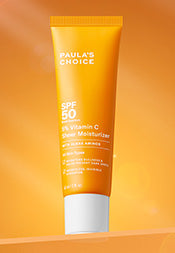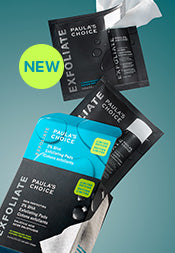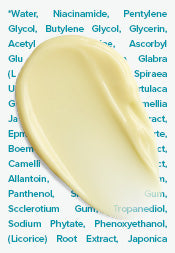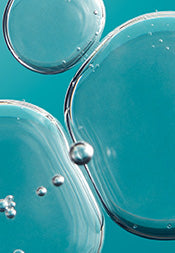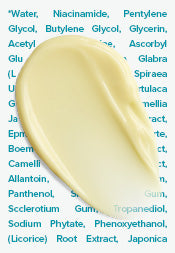How to Mix and Layer Skincare Boosters
Skincare boosters are specialised products that contain a high concentration of a single type of ingredient, such as vitamin C or a blend of non-fragrant plant oils, along with supporting ingredients that enable the main ingredient(s) to be even more effective. Adding one or more boosters to your routine allows you to customise your skincare routine and get visible results you'll find impressive.
Paula’s Choice skincare boosters are formulated to work together with each other and are designed to layer easily with other leave-on products in your skincare routine.
To help you learn how to combine our boosters for enhanced results pertaining to your specific skincare concerns, we’ve written some booster recipes. One of these might just be the “secret sauce” that takes your results to the next level. Let’s get cooking!
Skincare Concerns and Our Recipes
1. Concern: Brown Discolorations + Blemish-Related Sensitivities
Your Booster Recipe: BOOST C15 Super Booster + CLINICAL Discoloration Repair Serum
How to: After cleansing, toning, and exfoliating, apply 3-5 drops of C15 Super Booster to your entire face. Layer with spot treatment using the Discoloration Repair Serum. Follow with your serum, moisturizer, and eye cream.
Add some spice: If enlarged pores are also a concern, add a few drops of the BOOST 10% Niacinamide Booster to the mix right after applying after C15, then follow with the Discoloration Repair Serum and the rest of your routine.
2. Concern: Loss of Firmness & Elasticity + Fine Lines & Dehydration
Your Booster Recipe: BOOST Pro-Collagen Multi-Peptide Booster + BOOST 1% Retinol Booster
How to: After cleansing, toning, and exfoliating, dispense 2-3 drops of the Retinol Booster into the palm of your hand. Next, add a pearl-sized amount of Peptide Booster. Mix the two with your fingertips and apply to your face and neck. Follow with your serum, moisturizer, and eye cream.
Add some spice: Enhance a firm feeling around the eyes and reduce the look of fine lines and wrinkles by dabbing on a visible layer of RESIST Anti-Aging Eye Cream to end your night-time skincare routine.
3. Concern: Wrinkles + Loss of Firmness + Dull, Uneven Skin Tone
Your Booster Recipe: BOOST 1% Retinol Booster + BOOST C15 Super Booster
How to: After cleansing, toning, and exfoliating, dispense 2–3 drops of the Retinol Booster into the palm of your hand. Next, add 3–5 drops of the C15 Booster. Mix the two with your fingertips and apply to your face and neck. Follow with your serum, moisturizer, and eye cream.
Add some spice: A dash (a few generous drops) of BOOST Pro-Collagen Multi-Peptide Booster helps smooth the look of fine lines and wrinkles while hydrating and visibly strengthening your skin's resilience.
4. Concern: Large Pores + Rough Texture + Fine Lines & Wrinkles
Your Booster Recipe: BOOST 10% Niacinamide Booster + BOOST 1% Retinol Booster
How to: After cleansing, toning, and exfoliating, dispense 2–3 drops of the Niacinamide Booster into the palm of your hand. Add an equal amount of the Retinol Booster, mix them together with your fingertips, and then smooth the mixture over your face, focusing on areas with visible lines and large pores.
Add some spice: If your skin is dry or dehydrated — including seasonal dryness — finish your skincare routine by massaging 2–3 drops of BOOST Moisture Renewal Oil Booster over dry areas, including around the eyes. Dry, but not that dry? Follow with a few drops of the BOOST Pro-Collagen Multi-Peptide Booster to smooth and soften the appearance of wrinkles.
5. Concern: Wrinkles + Dehydration + Discolouration
Your Booster Recipe: BOOST Hyaluronic Acid Booster + CLINICAL Discoloration Repair Serum
How to: After cleansing, toning, and exfoliating, dispense 3–5 drops of the Hyaluronic Acid Booster and apply to your face and neck. Dispense a pearl-sized amount of the Discoloration Repair Serum and spot-apply to discolourations.
Optional: Add a bit more C15 Super Booster to larger areas where your skin tone appears uneven.
Add some spice: Dispense 3–4 drops of the BOOST 10% Niacinamide Booster and apply to your face and neck after the Hyaluronic Acid Booster. Niacinamide helps strengthen skin against moisture loss and further improves the appearance of discolourations and uneven skin tone.
6. Concern: Dry, Dehydrated, Sensitive Skin
Your Booster Recipe: BOOST Moisture Renewal Oil Booster + BOOST 10% Niacinamide Booster
How to: After cleansing, toning, and exfoliating, dispense 2–3 drops of the Niacinamide Booster and smooth the mixture over your face and neck. Follow with 2–3 drops of the Oil Booster, applied to dry areas, including around the eyes. You can also mix the Oil Booster with your facial moisturizer and apply this blend to your face and neck.
Add some spice: Mix in a pea-size amount of BOOST Hyaluronic Acid Booster with the Niacinamide Booster, and then apply a few drops of the Oil Booster, make sure you include the area around the eyes.
7. Concern: Wrinkles + Post-Acne Marks + Uneven or Dull Skin Tone
Your Booster Recipe: BOOST 10% Niacinamide Booster + BOOST C15 Super Booste
How to: After cleansing, toning, and exfoliating, dispense 2–3 drops of the Niacinamide Booster into the palm of your hand and apply it to your face and neck. Next, dispense a pea-sized amount of the Discoloration Repair Serum and dab it on blemish-prone areas and post-acne marks for more even-looking skin.
Optional: Add a bit more C15 Super Booster (try mixing it with your nighttime moisturizer) for larger areas of blemishes or uneven skin tone.
Add some spice: Dispense a pea-size amount of SKIN PERFECTING BHA 9 and apply it to clog-prone or bumpy areas to improve your skin’s texture.
References for this information
The Journal of Clinical and Aesthetic Dermatology, July 2017, pages 14-17
Journal of Cosmetic Dermatology, March 2016, pages 49–57
Clinical, Cosmetic, and Investigational Dermatology, September 2015, pages 463–470; and July 2015, pages 405–412
BioMed Research International, July 2015, ePublication
Clinical Interventions in Aging, January 2015, pages 339–349
Dermatology, May 2014, pages 314–325
Biochemical and Biophysical Research Communications, January 2013, pages 579–584


